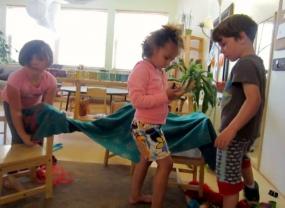Three Reasons to Build a Train of Chairs

These 7 minutes of video begin with three children looking for interesting ways to use moveable elements in their classroom: chairs, fabric, baskets. Ellymae takes the lead. Penelope joins now and then. Luther’s interests take him elsewhere after a minute or two. Why would teachers give so much time and space to free play? Here are some possible reasons with pointers to examples in the video clip. Leadership After losing Penelope as a partner, Ellymae shifts the game from tying fabric to aligning the chairs into a train 03:07. This motivates Penelope to join because the new goal has purpose, a familiar form, and joy. Ellymae explains to Penelope why they need the fabric over the chairs 05:26. She explicitly states the end goal 05:36. She praises the work in progress 06:05. These comments add purpose to their actions and motivate her co-player to buy into the game. Language Penelope lays a basket of craft materials, one on each of three seats. “This shows them how to eat. This shows them where to eat” 04:11.The change from how to where was a correction because Penelope realizes her actions are one of designating a location, not a procedure. It is interesting how often the girls correct their language, particularly their prepositions and adjectives, during play. The reality of their actions gives them a better way to compare what they say versus what they mean to say. They see what they mean to say. Problems Look at the many places the children have to deal with the technical problems of tying the fabric, placing it on top of the chairs, and arranging the chairs into a train. The fabric gets twisted 00:29. The ribbon is too long and bunches up 00:45. The fabric prevents a way to wrap the ribbon about both chair and fabric 02:54. The smooth and supple fabric slides off the back of the chairs 05:16. The fabric is too low to allow space for the passenger 06:30. The chairs are too close for the legs to fit 06:48. Some of these problems are solved. Some are abandoned. Some are allowed and folded into the pretense of the game. But all of these problems create opportunities for high level thinking as the children work with the materials and each other. And these are only three themes. You can also see evidence for the development of executive function (planning, focused attention, follow through), collaboration, flexible thinking, and narrative structure, to name a few. These moments of self-regulated play are important periods of the day and cannot be replaced by lessons. Length of video: 7 minutes Keywords: Fives, Chairs, Children-Children, Leadership, Problem Solving, Tying, Language, Collaboration
